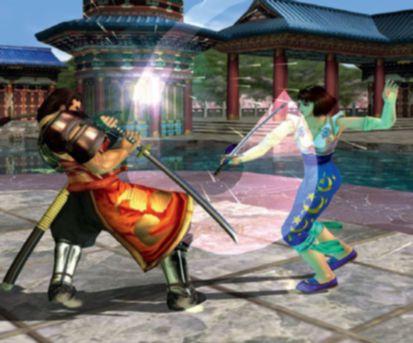
3 minute read
SoulcaliBur
i N g a y p l N o w
Revisiting the stage of history in the original Soulcalibur to see just how far the fighting series has come Daniella lucas
Publisher Bandai namco / DeveloPer Bandai namco / format XBoX 360 / release Date July 2008
With a new Soulcalibur game finally on the way this year I felt like now was the perfect time to go back to the series’ roots with the first entry. While it was originally launched on Dreamcast in 1999 it wasn’t released on Xbox 360 until 2008, just before the fourth game in the series came out.
Its appearance may have just been a way to build hype for the new (at the time) game in the run up to its release, but it will forever hold a special place in my heart as it’s the first game I ever reviewed for a magazine back when I was a plucky work experience person. This tiny online rerelease is what “Replaying this old game, it’s kickstarted my career, and after just shy of ten years I’ve finally returned not nostalgia I’m feeling – it’s to where it all started. But does it still feel as exciting now as it did to excitement for the future” me then?
For starters, I definitely relate more now to the ancient, angry husk that is Cervantes, rather than the youthful and sprightly Xianghua that I loved in 2008 – though I still suck at playing as the ghostly pirate. I did expect it to be muddy and brown in the looks department, but it’s wonderfully bright; it’s aged well even if the character models are a little square. I’m pretty sure that what is it? biceps aren’t supposed to have corners. Still, The starting point for the weapons-based fighting game series every movement is that came to XBLA nine surprisingly fluid – it years after its original feels great to manoeuvre release. around the stage.
Unlike other fighting games such as Street Fighter or Tekken, knocking someone out isn’t the only way to win a fight. The stages themselves are small, with very definite edges that you can shove an opponent off to end a match early. The arenas are usually very basic shapes here, but that added sense of drama of shunting someone off when they looked like they were winning is something that became a defining part of the Soulcalibur series. Though I’m not sure ‘drama’ is the right word when you accidentally mistime a jump kick and fall to a demise of your own making.
Making friends
The only really weak area is that some of the characters in the roster aren’t as distinguished as in later games. For example, the sword and shield-wielding Lizardman plays almost identically to Sophitia, and heavy axe users Rock and Astaroth are also alike. It definitely feels like they tried to pad things out to fit in more fighters, though thankfully they’re all a lot more nuanced in the later games as the series progressed. Maxi with his swirling Nunchucks is still a bastard, with movements that are difficult to cut into as he quickly nips at your health bar in constant little bites. But that makes finally beating him in arcade mode all the sweeter. He’s the first wall you’ll hit in terms of difficulty, but as soon as you figure him out he’s easy to overcome. It almost feels like a puzzle, though this sensation disappeared in later entries thanks to increasingly sophisticated AI. Like wrapping yourself up in a burrito of blankets, there’s always something comforting about playing old games, but replaying this, it’s not nostalgia that I’m feeling – it’s excitement for the future. All of Soulcalibur’s strongest points, such as its flamboyant weapons, perilous arena edges and directional movement, are pure here, but my head is full of the possibilities of what it could be when VI is released. With so many advances in gaming tech over the years there’s so much it could do to enhance its flourish-filled fighting style. n











